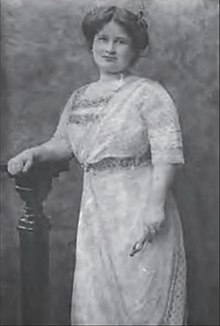Saliha Naciye Kadın
| Saliha Naciye Kadın | |||||
|---|---|---|---|---|---|
 | |||||
| Born | Zeliha Hanım Ankuap 1887 Batumi , Georgia | ||||
| Died | 1923 (aged 35–36) Serencebey Mansion, Istanbul, Turkey | ||||
| Burial | Mahmud II Mausoleum, Divan Yolu street, Istanbul | ||||
| Spouse | |||||
| Issue | Şehzade Mehmed Abid Samiye Sultan | ||||
| |||||
| House | Ankuap (by birth) Ottoman (by marriage) | ||||
| Father | Arslan Bey Ankuap | ||||
| Religion | Sunni Islam | ||||
Saliha Naciye Kadın[a] (Ottoman Turkish: صالحہ ناجیہ خانم, "the devout one" and "saved and freed"; born Zeliha Ankuap; 1887 – 1923) was the last consort of Sultan Abdul Hamid II of the Ottoman Empire.[2]
Early life[edit]
Of Abkhazian origin,[3] Saliha Naciye Kadın was born in 1887.[4] Born as Zeliha Ankuap, she was the daughter of Aslan Bey Ankuap.[3] In 1901, Kabasakal Mehmed Pasha, presented her for service in the Yıldız Palace,[5] where her name according to the custom of the Ottoman court was changed to Saliha Naciye.[6]
Marriage[edit]
Three years into service, Abdul Hamid took notice of Saliha Naciye, and they married on 4 November 1904 in the Yıldız Palace. She was 17 and he was 62. She was his thirteenth and last consort.[4] She was given the title of "Sixth Ikbal". She was very sweet, gentle and modest, characteristics appreciated by the sultan.[7] A year after the marriage, on 17 May 1905, she gave birth to her first child, a son, Şehzade Mehmed Abid,[8][9] and three years later on 16 January 1908 to her second child, a daughter, Samiye Sultan, who died on 24 January 1909. After her daughter birth, she was given the honorary rank of "Fifth Kadın", with title Saliha Naciye Kadın. Saliha Naciye was by far the favorite consort of Abdülhamid II, followed by Müşfika Kadın and Pesend Hanım.[10]
In the 1909 mutiny, Kabasakal ("twisted beard") was shaved and publicly hanged,[11] and on 27 April 1909, Abdul Hamid was deposed, and sent into exile in Thessaloniki.[12] Naciye was close to him,[13] and so she and her son Abid accompanied him. But after Thessaloniki fell to Greece in 1912, Abdülhamid returned to Istanbul and settled in the Beylerbeyi Palace,[7][14] where he died in 1918. Saliha Naciye refused to abandon Abdülhamid and, together with Müşfika Kadın, demanded to stay with him in Beylerbeyi Palace until his death. Pesend Hanım, on the other hand, was unable to obtain permission and therefore never saw her husband again, suffering greatly from this, so much so that she shaved her head as a sign of mourning at his death.[15]
Last years and death[edit]
After Abdul Hamid's death, Saliha Naciye settled in the mansion of Şehzade Mehmed Selim located in Serencebey.[16]
She died in 1923, and was buried in the mausoleum of Sultan Mahmud II, located at Divan Yolu street.[17][18]
Issue[edit]
| Name | Birth | Death | Notes |
|---|---|---|---|
| Şehzade Mehmed Abid | 17 May 1905[19][7][20] | 8 December 1973[19][7][20] | married twice without issue |
| Samiye Sultan | 16 January 1908[19][10] | 24 January 1909[19][10] | born and died in Yıldız Palace, She died because pneumonia and buried in Yahya Efendi Cemetery |
In literature and popular culture[edit]
- Saliha Naciye Kadın is a character in Tim Symonds' historical novel Sherlock Holmes and The Sword of Osman (2015).[21]
- In the 2017 TV series Payitaht: Abdülhamid, Saliha Naciye Kadın is portrayed by Turkish actress Vildan Atasever.[22]
See also[edit]
Annotations[edit]
References[edit]
- ^ Banoğlu, Niyazi Ahmet (1963). Anitlari ve tarihî eserleriyle Istanbul. Yeni C̣iǧir Kitabevi. p. 56.
- ^ Açba, Leyla (2004). Bir Çerkes prensesinin harem hatıraları. L & M. p. 123. ISBN 978-9-756-49131-7.
- ^ a b Ali Akyıldız (2018). Son Dönem Osmanlı Padişahlarının Nikâh Meselesi. pp. 697–698.
- ^ a b Yılmaz, Ö.F. (2002). Sultan Abdülhamit Han'ın harem hayatı. Eylül Yayınları. Eylül Yayınları. p. 95. ISBN 978-975-6597-15-6.
- ^ Sakaoğlu 2008, p. 681.
- ^ Nahid Sırrı Örik (1989). Abdülhamid'in haremi. Arba. p. 41.
- ^ a b c d Uluçay 2011, p. 252.
- ^ Bey, Mehmet Sürreya (1969). Osmanlı devletinde kim kimdi, Volume 1. Küğ Yayını. p. 126.
- ^ Ali Vâsib (2004). Bir Şehzadenin hâtırâtı: vatan ve menfâda gördüklerim ve işittiklerim. YKY. p. 73. ISBN 978-9-750-80878-4.
- ^ a b c Uluçay 2011, p. 259.
- ^ McCullagh, Francis (1910). The Fall of Abd-ul-Hamid. London: Methuen & Co. Ltd. p. 274.
- ^ Hall, Richard C. (October 9, 2014). War in the Balkans: An Encyclopedic History from the Fall of the Ottoman Empire to the Breakup of Yugoslavia. ABC-CLIO. pp. 1–2. ISBN 978-1-610-69031-7.
- ^ Tuğlacı, Pars (1985). Türkiyeʼde kadın, Volume 3. Cem Yayınevi. pp. 165, 195.
- ^ Sakaoğlu 2008, pp. 681–682.
- ^ Parry, Milman; Lord, Albert B. (1979). Serbocroatian heroic songs, Volume 1. Harvard University Press. p. 371.
- ^ Akyıldız, Ali (2018). Son Dönem Osmanlı Padişahlarının Nikâh Meselesi. p. 701.
- ^ Şehsuvaroğlu, Haluk Y. (2005). Asırlar boyunca İstanbul: Eserleri, Olayları, Kültürü. Yenigün Haber Ajansı. p. 223.
- ^ Banoğlu, Niyazi Ahmet (1963). Anitlari ve tarihi eserleriyle Istanbul. Yeni çigir kitabevi. p. 56.
- ^ a b c d Osmanoğlu 2000, p. 264.
- ^ a b Brookes 2010, p. 278.
- ^ Symonds, Tim (October 14, 2015). Sherlock Holmes and The Sword of Osman. Andrews UK Limited. ISBN 978-1-780-92756-5.
- ^ Payitaht: Abdülhamid (TV Series 2017– ), retrieved 2020-12-29
- ^ Sakaoğlu 2008, p. 680.
- ^ Örik, Nahid Sırrı (2002). Bilinmeyen yaşamlarıyla saraylılar. Türkiye İş Bankası. p. 145. ISBN 978-9-754-58383-0.
Sources[edit]
- Brookes, Douglas Scott (2010). The Concubine, the Princess, and the Teacher: Voices from the Ottoman Harem. University of Texas Press. ISBN 978-0-292-78335-5.
- Osmanoğlu, Ayşe (2000). Babam Sultan Abdülhamid. Mona Kitap Yayinlari. ISBN 978-6-050-81202-2.
- Sakaoğlu, Necdet (2008). Bu Mülkün Kadın Sultanları: Vâlide Sultanlar, Hâtunlar, Hasekiler, Kandınefendiler, Sultanefendiler. Oğlak Yayıncılık. ISBN 978-6-051-71079-2.
- Uluçay, M. Çağatay (2011). Padişahların kadınları ve kızları. Ötüken. ISBN 978-9-754-37840-5.


